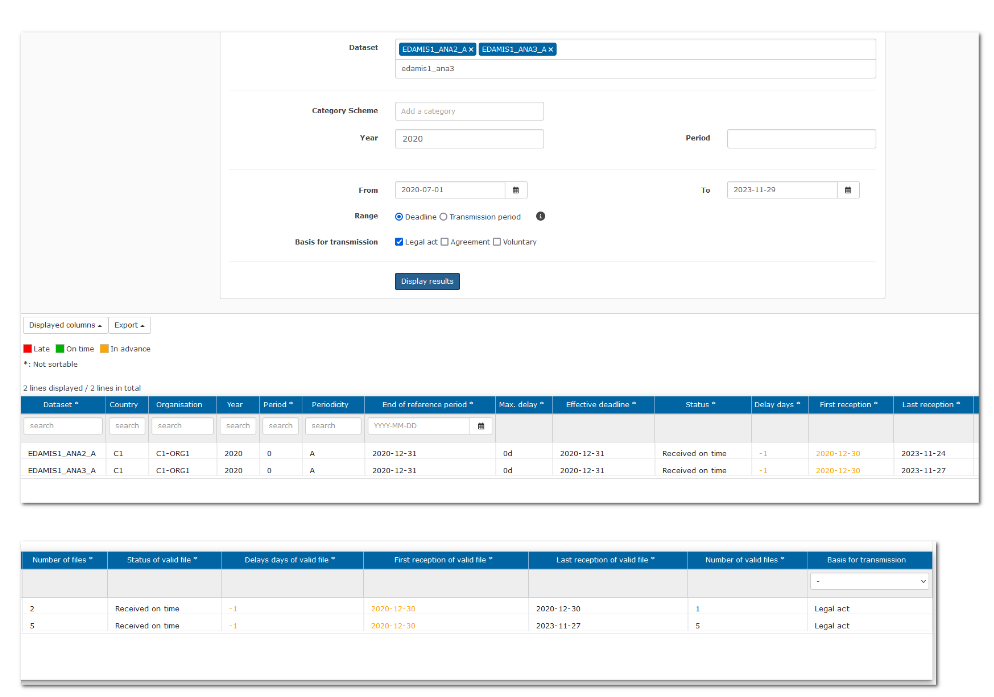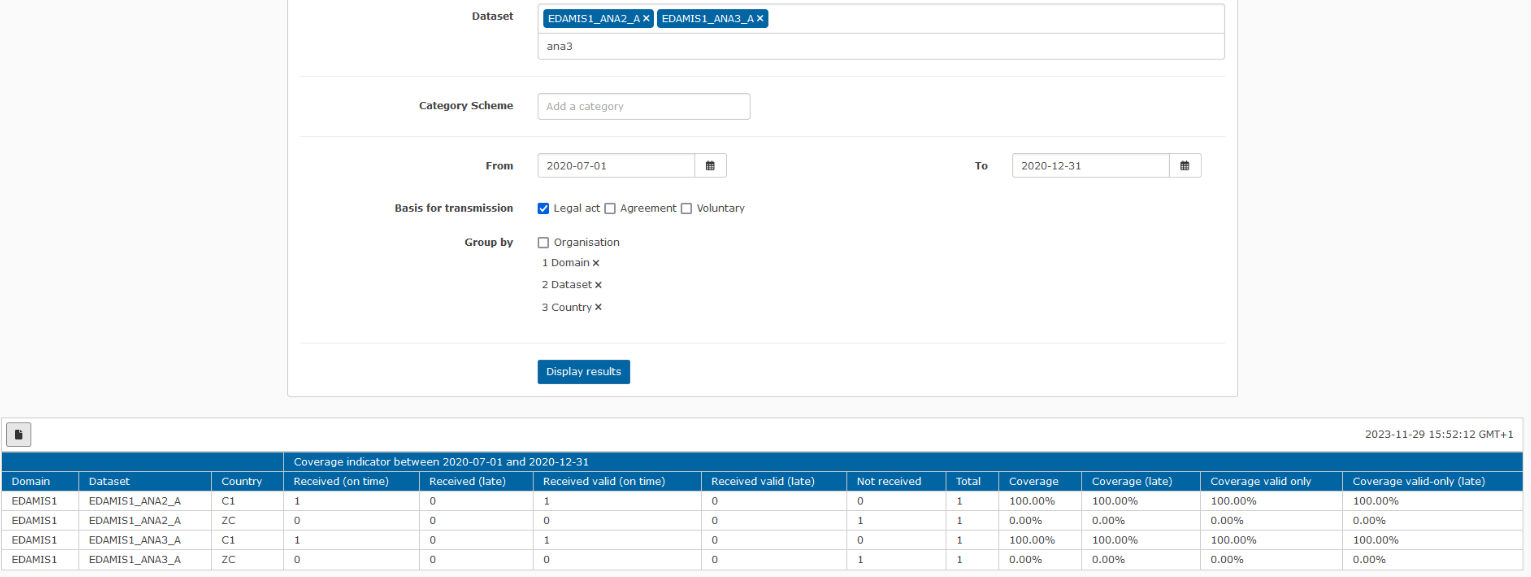The “Timetable between Dates Detailed” and the “Coverage indicator” are reports which can be used to track whether expected transmissions were made by the deadline encoded in EDAMIS. They are mainly used by Domain Managers, Domain Co-responsible and Transmission Coordinators.
Timetable between Dates Detailed report
The Timetable report displays the list of dataset occurrences for which transmissions are expected. A dataset occurrence is a combination of a dataset, provider and reference period for which data files are expected to be submitted, whereas a transmission is a specific submission of a data file for an occurrence.
The dataset occurrences listed can be filtered by time range, datasets, and data provider.

The report contains information for each expected dataset occurrence, and it is divided in three group of columns.
The first group provides information about the expected transmission date (max delay, effective deadline).
The second group provides information about the status of transmissions without taking in account the validation status (status, delay days, first reception, last reception, and number of files).
The third group provides information about the status of transmissions taking in account the validation status (status of valid file, delays days of valid file, first reception of valid file and last reception of valid file, and number of valid files).
First Group:
Max. Delay: duration of the transmission period.
Effective deadline: date by which a first transmission for the dataset occurrence is expected. Starting January 2024, transmissions deadlines falling on weekends are moved to the following Monday, in line with the general rules put in place by regulation 1182/71.
Second Group:
Status: status of the transmissions for the dataset occurrence.
- Received on time: the first transmission for the selected dataset occurrence was received before the effective deadline.
- Received late: the first transmission for the selected dataset occurrence was after the effective deadline.
- Expected: the first transmission for the selected dataset occurrence has not been received yet and the effective deadline has not yet passed.
- Not received: the first transmission for the selected dataset occurrence has not been received yet.
Delay days: the number of days before or after the effective deadline when the first transmission for the dataset occurrence was received. In case a transmission was made before the deadline, the number of days is displayed with a negative value.
First reception: the date at which the first transmission was received for the selected dataset occurrence.
Last reception: the date at which the last transmission was received for the selected dataset occurrence.
Number of files: the number of files received for the selected dataset occurrence.
Third group:
The third group of columns refers only to “valid” transmissions, meaning transmissions which successfully passed the validation (STRUVAL and/or CONVAL):
Status of valid files: the status of transmissions for the dataset occurrence. Same as above, but only considering valid transmissions.
Delay days of valid file: number of days before or after the effective deadline when the first valid transmission for the dataset occurrence was received. In case a valid transmission was made before the deadline, the number of days is displayed with a negative value.
First reception of valid file: the date at which the first valid transmission was received for the selected dataset occurrence.
Last reception of valid file: the date at which the last valid transmission was received for the selected dataset occurrence.
Number of valid files: the number of valid transmissions received for the selected dataset/occurrence.
Transmissions are considered valid if they have validation status “OK” or if no STRUVAL and/or CONVAL implementation was available for them. If no valid transmissions were made, no result is displayed in the columns.
The rules applied in the Timetable report are the same rules applied in the Coverage for files received, not received (valid or not).
Coverage indicator report
The Coverage report indicates the number and percentage of expected data transmissions that have been performed in a specific time range for the selected datasets and data providers.
As mentioned above, the Coverage and the Timetable reports apply the same rules to calculate if a file has been received on time or late and if it is considered valid or not.
The report can be obtained by country and organisation or for a specific domain/dataset.

Received (on time): the number of dataset occurrences for which the first transmission was received by the effective deadline for a selected dataset / data provider regardless of the validation status.
Received (late): the number of dataset occurrences for which transmission the first transmission was after the effective deadline for a selected dataset / data provider regardless of the validation status.
Not received: the number of dataset occurrences for which no transmissions were received for a selected dataset / data provider.
Coverage: the number of dataset occurrences for which the first transmission ws received by the effective deadline regardless of the validation status divided by the total number of expected dataset occurrences for a selected dataset/data provider.
Coverage (late): the number of dataset occurrences for which a transmission was received before or after the effective deadline regardless of the validation status divided by the total number of expected dataset occurrences for a selected dataset/data provider.
Received valid (on time): the number of dataset occurrences for which the first valid transmission was received by the effective deadline for a selected dataset / data provider.
Received valid (late): the number of dataset occurrences for which the first valid transmission was received after the effective deadline for a selected dataset / data provider.
Coverage valid only: the number of dataset occurrences for which the first valid transmission was received by the effective deadline divided by the total number of expected dataset occurrences for a selected dataset/data provider.
Coverage valid only (late): the number of dataset occurrences for which a valid transmission was received before or after the effective deadline divided by the total number of expected dataset occurrences for a selected dataset/data provider.
